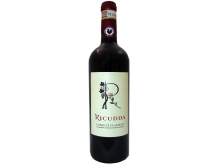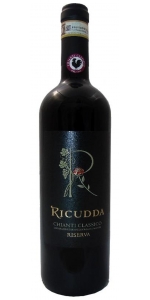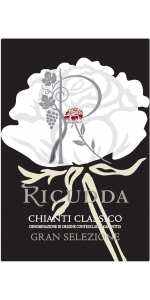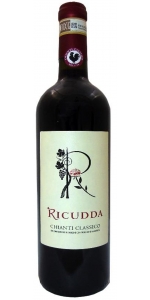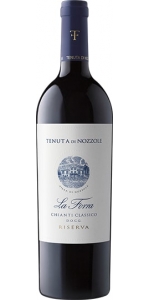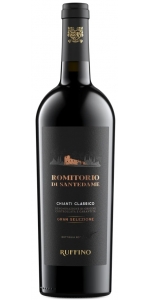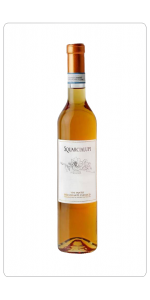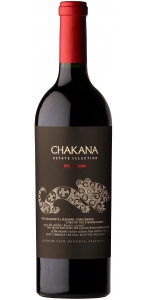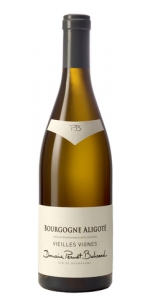Ricudda Chianti Classico 2020
| Country: | Italy |
| Regions: | Tuscany Chianti |
| Winery: | Fattoria Ricudda |
| Grape Type: | Sangiovese |
| Organic: | Yes |
| Vintage: | 2020 |
| Bottle Size: | 750 ml |
Ricudda Chianti Classico Riserva 100% Sangiovese.
Deep ruby red color.
The wine shows an intense and persistent bouquet, with notes of berries and spices such as licorice and black pepper. Well-harmonized hints of oak.
In the mouth, it is well structured and balanced, complex, persistent with notes of red fruits and spices such as black pepper and licorice.
Pair with grilled red meats, steak, game of hair and feather, stewed and roasted, aged cheeses hard like pecorino.
Wine with great structure, intensity and complexity.
Intense aromas of toasted oak, ripe red fruits, accompanied by spices and balsamic notes.
Aged 24 months in Oak barrels from forrests in the center of France.
Pairs well with grilled meats, game meat and aged hard cheeses.
Intense ruby red color with purple tints.
On the nose, the wine shows some intense notes of red fruits, especially cherry and slight hints of oak.
In the mouth, it has a good structure, great softness and it is pleasant to drink. Predominant notes of red fruits, with slight spiciness.
Pair with first courses with game, grilled meats, fresh and aged cheeses such as pecorino.
Tenuta di Nozzole La Forra Chianti Classico Riserva is made from 100% Sangiovese.
Located north of the village of Greve in the heart of the Chianti Classico region, the Nozzole estate covers a striking, rugged, mountainous area of about 1,000 acres at 984 feet in elevation. In order to obtain concentration and complexity in the wine, yields are kept low. The grapes are hand harvested, destemmed and crushed. Fermentation is initiated on the skins in temperature-controlled stainless steel tanks, followed by a maceration period to draw out color and tannins. The wine is racked into stainless steel tanks for malolactic fermentation before aging in oak vats and in bottle before release. The wine is bottled on the estate.
The 2020 vintage was characterized by a basically cold period between April and May and by a generally warm and dry climate until July. The initial slight delay of the vegetative cycle has been recovered since the summer. The sudden increase in temperatures, especially for the later varieties where the fruit set had not yet ended, has favored a production characterized by sparse and light bunches. The stable and sunny climate of the months of August and September allowed the grapes to complete ripening in optimal conditions.
- A classic, traditional Chianti from the Folonari family, making wine since the 1700s
- Matured in oak barrels
- Estate bottled, from a highly regarded estate
Review:
Attractive on the nose with cherries, red berries, dried herbs and baking spices. It’s medium-bodied with fine tannins. Harmonious and poised with a refined character. Weightless and agile. Polished and succulent finish.
-Wine Enthusiast 93 Points
Ruffino Romitorio di Santedame Chianti Classico Gran Selezione DOCG is made from 90% Sangiovese, 10% Colorino.
Romitorio di Santedame, a limited-production Gran Selezione from Castellina in Chianti, pays homage to a rich history while embracing a bright future. It originates from a single vineyard within the Chianti Classico's "golden basin" (Conca d'Oro) and is crafted from an exclusive blend of Sangiovese and Colorino. The latter is a native Tuscan grape variety that was nearly extinct but has experienced a revival through dedicated research and promotion efforts.
Fruity aromas typical of Sangiovese, including black cherry and ripe plum, with violet and complex chocolate and black pepper notes. The palate offers sweet tobacco and balsamic hints, while its balanced structure with refined tannins and lively acidity makes it suitable for extended aging.
Review:
You feel the oak here, suggesting vanilla and clove character, but it’s very well complemented by the dark fruit, ranging from blackberries to mulberries to dark cherries. Full-bodied, dense and decadent with a regal structure and muscular tannin backbone. The acidity cuts nicely through on the long finish and provides freshness. Drink from 2024.
-James Suckling 94 Points
Bojola Vin Santo del Chianti Classico is a fortified dessert wine made from Malavasia del Chianti and Trebbiano Toscano varietals.
Amber in color, intense nose with strong notes of dried fruit, accompanied by hints of walnut and juniper. Dense mouth feel with notes of dried fruit and quince jam.
Pairs well with desserts, biscuits, dried fruits and cheeses.
Intense ruby red color with purple tints.
On the nose, the wine shows some intense notes of red fruits, especially cherry and slight hints of oak.
In the mouth, it has a good structure, great softness and it is pleasant to drink. Predominant notes of red fruits, with slight spiciness.
Pair with first courses with game, grilled meats, fresh and aged cheeses such as pecorino.
Review:
"A lovely red from a hot vintage, showing freshness and brightness. Medium body with orange-peel and cherry flavors that last effortlessly on the palate. Tangy. From organically grown grapes. Drink now."
- James Suckling (June 2022), 93 pts
The Ricudda Farm is located along a secondary route of the ancient Via Francigena, which in ancient times was traveled by pilgrims who went from France to Rome and descended from the ridge of Castellina in Chianti towards the main routes of the Val D’Elsa.
It takes its name from the French Coude / Couder / Recoude, which has the meaning of “elbow, bend”.
The name of the farm can therefore be traced back to the "elbow" conformation of the farm land.
The Fattoria has been producing wine since the 15th century and is one of the oldest farms in the Chianti area. It is located in the municipality of Castellina in Chianti about halfway between Florence and Siena, at an altitude of about 360 m a.s.l. The farm and its grounds boast almost 800 years of history, from the first known acquisition a few years before 1300 by Bartolomeo di Grazia, a Florentine citizen of the time, who started production until our acquisition. The Squarcialupi family, the most powerful family in the history of Chianti, is also among the owners of the land. In 2016 the company
was acquired by the Bojola - Australi families with the aim of converting production towards a 100% organic product. 6 hectares of new vineyards were replanted, modern equipment was purchased and the old farm that houses the farm and farmhouse was renovated. The result is a production of high quality Chianti Classico with Sangiovese grapes and organic olive oil.
Chakana Estate Red Mendoza is made from 70% Malbec, 25% Cabernet Sauvignon, 5% Cabernet Franc
Deep red color with violet hints. Dark fruits and exotic spices with tobacco and mocha hints. Elegant, well balanced, harmonious, long persistence with chocolate flavors.
Vineyard: Gualtallary in Valle de Uco.
2 days maceration on skins in temperature controlled steel vats; 12 days fermentation with selected yeasts allowed to rise to a maximum of 28°C.
Review:
"Notes of fresh blackcurrants and dark cherries with subtle hints of nutshells, cocoa and spice box. Rich and flavorful on the palate with a medium to full body and ripe, glossy tannins. Succulent, lightly spicy finish. Malbec, cabernet sauvignon and cabernet franc. Vegan. Drink or hold."
- James Suckling (February 2024), 91 pts
Pernot Belicard Aligoté is produced from old vines planted in 1956 and 1971 by Philippe Pernot's grand father.
Wine is very aromatic, with some tropical notes with a hint of white flowers and white peach. The wine is also quite mineral, due to the Aligote grapes grown on limestone soils in the commune of Puligny Montrachet. Finish is long and balanced.
Oysters, St Jacques Cassolette, Roasted Gambas, Comté Cheese.
- back
Boroli Cerequio is made from 100 percent Nebbiolo.
The Boroli family is a family of entrepreneurs, with roots in Piedmont dating back to 1831. The family started their winemaking business in1997, when Silvano and Elena Boroli felt an ardent desire to step away from the pressures of their publishing business and reconnect to nature. Silvano and Elena grew the company until their son, Achille, stepped in to run the wine-growing and production business in 2012.
With the 2012 grape harvest Achille decided to radically change the methods used in vineyards and wineries, aiming for the highest quality in Barolo and its crus. He cut production levels, updated the winemaking technology, and focused on low intervention methods to raise the quality of the Boroli wines be on par with the finest Barolo wines.
About the Vineyard
The Cerequio cru lies just across the valley from the Boroli winery in the commune of La Morra and is considered one of the most prestigious sites in the Barolo DOCG zone. It is known to produce Nebbiolo wine of enormous elegance and finesse.
Wine Production
Cerequio is distinguished by a careful selection of grapes, precise destemming, and a long maceration with submerged cap.
Tasting Notes
A clear bright ruby color with very light garnet red reflections; intense and persistent aroma of red fruit with notes of plum and cherry. A pleasant aroma of wood is noticeable after the fruity aroma, anticipating the full taste of a great wine suitable for long lasting life. A succulent, rich, full-bodied and pleasant taste emerges after the woody one, with the presence of slightly ripe red fruit.
Food Pairing
Thanks to its viscosity and body, Barolo is the ideal wine to pair with elaborate dishes and dishes like truffle dishes, meat dishes, pasta with porcini mushrooms, game, and aged cheeses. Cerequio is also perfect with dry pastries or chocolate.
Review:
Precise and essential, it displays notes of lavender, hibiscus, violet, white pepper, lime, jasmine flowers, and elderberry. Medium body, perfectly ripe, fine-grained tannins, and a juicy finish that displays smoothness and relaxation. Beautiful right away, it will only improve from 2024 onwards. One of the best Barolos tasted in the 2019 vintage.
-WineCritics.com 96 Points
Larroque Bordeaux Blanc is made from 73% Sauvignon Blanc and 27% Colombard.
No oak.
Color : Pale yellow with green tints.
Nose : Complex aromas of white flowers, exotic fruits, citrus and boxwood, with a touch of minerality.
Mouth : Aromatic, with a nice richness and freshness. Predominant flavors of tart, crisp fruit.
Marie-Christine, the daughter of Henri Ducourt, purchased this prestigious left-bank property in 1979, which lies on the border of the Graves appellation.
The 60-hectare vineyard was rapidly replanted and the château building, which dates from 1348, was restored.
Our family now produces three different-colored wines there: red, white and rosé.
Grown on loamy-clay soil.
Harvest : Machine harvesting in the cool, early morning
Maceration : Skin-contact maceration for several hours, depending on ripeness, and pressing
Fermentation : Beginning of the cold alcoholic fermentation (12°C / 53°F) then an increase in temperature to finish the fermentation at 20°C / 68°F.
Enjoy this wine as an aperitif or during the meal with fish, seafood or chicken salad.

